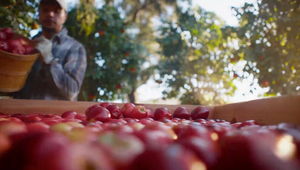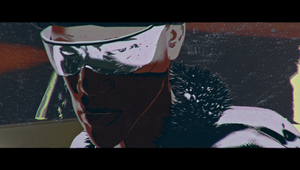
“Capturing the World the Way It Is”: Simon Ratigan’s Search for Stories Goes Stateside

“It’s been an amazing creative ride. From my first, early days, tentative (and very scary) steps at directing, to shooting some of the very best stuff in advertising. I have enjoyed every minute of it and still can’t quite believe how far you can go in this business by simply relying on instinct and trusting in collaboration.”
Immortal words from director Simon Ratigan, who for the past 20 years has been based in London, directing renowned commercials for brands including Eurostar, Save the Children and Specsavers. But, the ride’s not over yet, as it was announced last year that he’d signed to production company Chelsea Pictures for his first ever representation in the US.
He’s a director that’s willing to always go the extra mile, which is exemplified by his commitment to ‘overshooting’, to ensure there’s always a golden nugget of footage stashed in his back pocket. A director who was brave enough to “fly a washing machine over the Pyrenees” and affix propellers onto lawnmowers without VFX to prove the statement, ‘Anything Can Fly’, launching the now globally recognised rewards system, Avios air miles.
Recounting the experience, Simon explains, “It was a mad idea about everyday objects flying through the air. Madder still, the agency wanted to do it for real. No CGI. And to add to the insanity, they decided to not use film SFX people, but two farm-machinery mechanics who lived miles from anywhere. It was one of those gulp moments, because no one really knew if it would ever be possible to skim a boombox along a river or fly a washing machine over the Pyrenees. Who would? We tested, failed, tested again, failed again, but just kept going and after two months of anxiety, disappointment and trauma, we did. It seemed impossible at the start, yet we made it happen. I’m very proud of that.”
Known for his unique documentary style and ability to capture human emotion and realism, Simon is testament to the undying, universal pull of a good story that people can see and recognise themselves in. A process that, for him, begins at the very beginning of the production process – the script.
“The first question I ask myself about a script or a scene is – does it seem real? Do the actions, expressions and reactions of the protagonists feel genuine? What would I do, and how would I react in the situation?” He says, “When my instincts don’t align with the script, I simply focus on reworking those elements at the treatment stage. If I get that right and people buy into why I’ve changed things, then when we start filming, the revised scenes immediately feel more real and more emotional as a result.”
Those ‘instincts’ are shaped by Simon’s attentive eye and ability to turn an everyday observation into a distinct storytelling moment, a skill that helps his practice consistently evolve and stay ever-relevant. He reflects, “I’m constantly out in the world, assimilating life, filtering what I see and refining my shooting process in order to capture the beauty of the real world and the essence of what it is to be human.”
After so many years behind the camera, you might expect a director to have some well-tested shortcuts or timesavers up their sleeve, especially now, as production demands call for the type and volume of content required out of each shoot to increase. But for Simon, the secret to his success has always been rooted in the idea of ‘overdelivering’. He explains, “Despite the growing demands for different formats, on-set photographers and filming multiple versions of scripts, for me, overdelivering (or over-shooting) is absolutely key to my process.”
It allows for greater creative flexibility, stepping away from the carefully storyboarded scenes to find unplanned, yet often invaluable moments that enhance the final film, described by Simon as “unexpected cinematic gems”. It’s a helpful tool too, as the extra footage can often be crucial at the editing stage, or even serve as “great options in the back pocket for when a senior client blows out a critical shot or scene”.
He emphasises, “Given the pressure and demands on today’s directors, I’m still confident and committed to getting that extra material. It just comes down to being super time efficient on set and working hard to gain the trust of everyone involved. Trust equals speed equals more shots in the can.”
What has come with his years of experience, however, is the depth of knowledge and technical understanding that comes alongside having worked with so many clients and agencies. He reflects, “I’ve always loved directing commercials. And the experience I’ve gained over the years now makes it even more enjoyable. Not only do I have a better understanding of what works creatively, but I also get the bigger picture, which is a huge help when it comes to collaborating with agencies and clients.”
Continuing to push boundaries and his creativity further, Simon recently finished work on his first feature length documentary project (which he also edited too, just to prove he could). Titled, ‘Alex Lewis: Mountain’, the film took over five years to complete, and saw Simon follow quadruple amputee Alex Lewis into the UNESCO World Heritage wilderness as they attempted to become the first team of amputees to summit Ethiopia’s highest mountain.
The film has screened at festivals around the world, and was awarded Best Documentary at its premiere at London Independent Film Festival, among other accolades. Despite the intensity and scale of the project, Simon described filming as, “an absolute joy”, and “so cinematically freeing”, that his next documentary feature is already underway.
Driven by the opportunity to do something different, Simon’s entry into the US market is an exciting extension of this, opening doors to new clients, brands and production teams to collaborate with and create work that resonates. “I love those jobs where a client or agency is unsure if an idea will work or how to execute the script and I get to work alongside them to find a creative solution.” says Simon. “These types of projects offer me the greatest license to explore a concept creatively and challenge myself which invariably leads to something new. There’s a kind of energising mental freedom that makes the whole process exciting and keeps the ideas fresh.”
The US is full of fresh ideas for Simon to get stuck into, but this wasn’t the only factor behind his decision to head across the pond, he explains. “Over the years the calibre of work in the US has just got better and better. There’s cutting edge creative thinking, sensible budgets and immediate access to world class crews. This is a powerful draw for any director. However, it was on meeting Lisa Mehling, owner and president of Chelsea, talking to her team and discovering a shared creative spirit that persuaded me to cross the pond. I’ve never been represented by a US production company, but with Lisa’s support and the energy of the Chelsea team, I know we will be making some inspiring work together.”
It’s a catalogue of work that’s already started to take shape, as Simon’s first spot with the production company for food retailer Albertsons, was released last year. Working with ad agency, Anomaly, production took place in LA, “where the mayor declared a state of emergency on the first day of the shoot,” Simon reflects. “The rain had been unrelenting for almost a week, but despite the flooding, landslides, leaks in ceilings and nightmare roads, everyone came together and the shoot went remarkably well. The Chelsea team was really tight and, of course, LA crews are so good that we raced through the schedule.”
Despite the difficult production situation, the resulting spot is brimming with vibrancy, colour and life – showing the real people behind the food on offer in store. Most importantly, even with the tight shoot schedule, the team “still had time to capture some unscripted content which made all the difference in the final edit” – testament to Simon’s willingness to always go that extra mile.
Gearing up for the experiences coming his way, Simon reflects, “I’m a sucker for new challenges and creative unknowns, of which I’m sure there will be plenty as I get to know the country better.” But ultimately, he’s driven by the same instinctual need to tell stories that has guided his career thus far: “The need to capture what is genuine in the world in a way that is beautiful and emotionally impactful is what drives me. With the help of Chelsea, I want to immerse myself in the lives and landscapes of the country and bring a new level of authentic beauty to people’s screens.”















